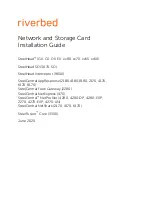
User Guide • PC1-GROOVE • Core
TM
i7
CompactPCI
®
CPU Board
Thermal Considerations
In order to avoid malfunctioning of the PC1-GROOVE, take care of appropriate cooling of the
processor and system, e.g. by a cooling fan suitable to the maximum power consumption of the CPU
chip actually in use. The processor contains digital thermal sensors (DTS) that are readable via special
CPU registers. DTS allows to get the temperatures of each CPU core separately.
Two further temperature sensors located in the system hardware monitor LM87 allows for acquisition
of the boards surface temperature and the thermal state of the onboard system memory channel.
Beside this the LM87 also monitors most of the supply voltages. A suitable software on Microsoft
Windows® systems to display both, the temperatures as well as the supply voltages, is
Speedfan
,
which can be downloaded from the web. After installation, both temperatures and voltages can be
observed permanently from the Windows® taskbar.
The PC1-GROOVE is equipped with a passive heatsink. Its height takes into account the 4HP limitation
in mounting space of a
CompactPCI
board. In addition, a forced vertical airflow through the system
enclosure (e.g. bottom mount fan unit) is strongly recommended (>20m
3
/h or 2m/s (400LFM) around
the CPU slot). Be sure to thoroughly discuss your actual cooling needs with EKF. Generally, the faster
the CPU speed the higher its power consumption. For higher ambient temperatures, consider
increasing the forced airflow to 3m/s (600LFM) or more.
The table showing the supported processors above give also the maximum power consumption (TDP
= Thermal Design Power) of a particular processor. Fortunately, the power consumption is by far
lower when executing typical Windows® or Linux tasks. The heat dissipation increases when e.g.
rendering software like the Acrobat Distiller is executed.
The Core
TM
i7 processors support Intel's Enhanced SpeedStep® technology. This enables dynamic
switching between multiple core voltages and frequencies depending on core temperature and
currently required performance. The processors are able to reduce their core speed and core voltage
in multiple steps down to 1200MHz (667MHz for ULV processors). This leads to an obvious reduction
of power consumption resulting in less heating. This mode of lowering the processor core
temperature is called TM2 (TM=Thermal Monitor).
Another way to reduce power consumption is to modulate the processor clock. This mode (TM1) is
achieved by actuating the 'Stop Clock' input of the CPU. A throttling of 50% e.g. means a duty cycle
of 50% on the stop clock input. However, while saving considerable power consumption, the data
throughput of the processor is also reduced. The processor works at full speed until the core
temperature reaches a critical value. Then the processor is throttled by 50%. As soon as the high
temperature situation disappears the throttling will be disabled and the processors runs at full speed
again.
These features are controllable by BIOS menu entries. By default the BIOS of the PC1-GROOVE enables
mode TM2 which is the most efficient.
The following diagram shows the performance derating with increasing temperature for an i7-610E
processor running at its maximum (2.53GHz) and minimum (1.20GHz) frequency as well as an i7-
660UE ULV processor at 1.33GHz.
© EKF -19- ekf.com
Содержание PC1-2-GROOVE
Страница 16: ...User Guide PC1 GROOVE CoreTM i7 CompactPCI CPU Board PC1 GROOVE Top View PC1 GROOVE Bottom View EKF 16 ekf com...
Страница 25: ...User Guide PC1 GROOVE CoreTM i7 CompactPCI CPU Board EKF 25 ekf com...
Страница 26: ...User Guide PC1 GROOVE CoreTM i7 CompactPCI CPU Board EKF ekf com 1 2 3 4 5 6 7 8 4s EKF 26 ekf com...
Страница 43: ...User Guide PC1 GROOVE CoreTM i7 CompactPCI CPU Board PR1 RIO w on Board PE Cable Connectors EKF 43 ekf com...
Страница 44: ...User Guide PC1 GROOVE CoreTM i7 CompactPCI CPU Board PC1 GROOVE PR1 RIO PC1 GROOVE PR1 RIO EKF 44 ekf com...
Страница 79: ...User Guide PC1 GROOVE CoreTM i7 CompactPCI CPU Board PC1 GROOVE EKF 79 ekf com...















































